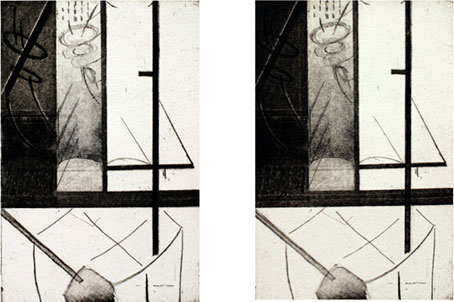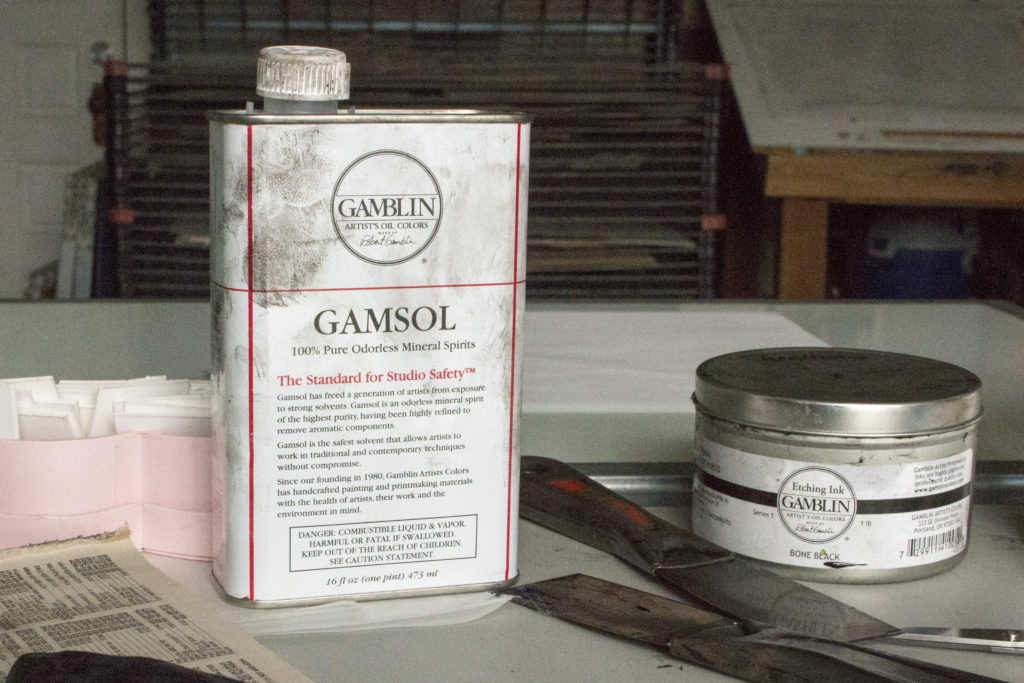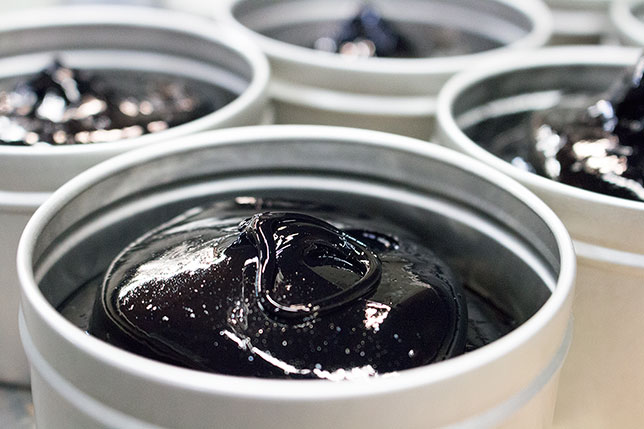
When choosing an ink, the questions to ask are ones focused on printability. An ink needs to perform throughout the printing process and also to serve the final image.
Many artists are used to inks needing modification with plate oil, tack reducer, or other additives each time they print. This often results in complex mixtures of ink and modifiers which can be difficult to replicate in future projects – and all just to be able to pull a decent print.
We believe the best recipe for a successful print, and for permanence, is to use inks that require little to no modification to print properly. By using an ink formulated specifically for your chosen technique, unnecessary customization, waste, and variables can be eliminated from the process. For this reason, we have formulated a line of Relief Inks in addition to our line of Etching Inks.
Whether you are using Gamblin Inks or those of another ink manufacturer, there are three considerations that can guide artists to the appropriate ink (in this case the appropriate Black ink) for their project.
- Printing Method: Are you creating an intaglio, relief, or monotype?
- Working properties: How does it roll out? How does it wipe? Does it leave a lot or a little plate tone?
- Color: Does the final image need to feel warm or cool? Does it need to give a feeling of depth?
By considering how you need the ink to roll out (in the case of relief printing), how the plate needs to wipe and how much plate tone would benefit your print, it will become easier to choose an ink suited to your project. For simplicity, we will discuss Working Properties and Color within the context of each Printing Method.
Black Ink for INTAGLIO: Etching Inks
We have developed five Blacks and Graphite for printmakers using intaglio printing processes. Gamblin Etching Inks are designed for printmakers who need a strong line and a great sensitivity to detail. Each black is designed to meet specific needs in both depth of color and printability.
Working Properties
With the wide array of techniques that fit under the intaglio umbrella comes the need for a range of working properties to accommodate them.
At a basic level, intaglio inks must be able to be wiped from the plate without pulling ink from the incised lines and the remaining ink must then transfer fully to the paper. Beyond this, there are a range of working properties to choose from. If an image would be best served by having strong contrasts in value, it may be ideal to use an ink that wipes easily and leaves very little plate tone. An ink with these working properties would not be ideal for a mezzotint, for which a stiffer ink is better suited.

Example of the same plate printed with two different black inks. Bone Black (L) wipes easily leaving less plate tone. Portland Stiff Black ( R) stiffer ink leaving more plate tone. Prints by Kazuko Watanabe.
Color
Most black pigments are not perfectly neutral in color. In the masstone (lines or heavy rollouts)the color temperature is imperceptible, but each ink leaves a plate tone that is either warm or cool. These color differences, while subtle, can affect the overall look and feel of a finished print.
To illustrate, Bone Black and Carbon Black vary significantly in working properties; but they share a warm color temperature. While they are very strong blacks, the warmth can lessen the feeling of depth to some artists, so a more neutral or cool black may be a better fit.
Gamblin Etching Inks
The Portland Black Inks were developed specifically for edition printers who want inks with excellent working characteristics. They offer printmakers:
- deep rich blacks
- great sensitivity to line and detail
- total control of plate tone
- the most potential for subtle value shifts
Portland Black
Formulated to wipe with ease, offers a moderate level of plate tone ideal for creating subtle value shifts, and still prints sensitive plates like drypoint beautifully. This ink will be the choice of those doing edition printing, and those working in schools that need an ink for general printing techniques. Portland Black is neutral in color.
Portland Cool Black
Cool in color with the same working properties as Portland Black.
Stiff Portland Black
Ideal for engravers, printers of mezzotints, or others who need more resistance from their ink.
Bone Black
A traditional black that is warm in color, wipes easily, and leaves very light plate tone. The combination of the light plate tone and easy wiping makes it less suited to works that require a subtle value range and ideal for work that requires strong contrasts.
Carbon Black
A silvery, dense black with a heavy plate tone. It is one of the most difficult black inks to wipe but remains in favor due to the strong, deep blacks it can produce. Like Bone Black it also has a warm plate tone.
Graphite
Makes prints look like pencil drawings – low contrast and a great sensitivity to the grey scale.
**Note: As printmakers develop their own preferences for the qualities of an ink that print their plates best, this information should be considered a guideline.
Black Ink for RELIEF Printmaking
Portland Intense Black
Black ink for all forms of relief printmaking. It rolls out smoothly, and easily transfers solid fields of color and fine detail from block to paper.
Working Properties
Many artists modify etching or lithography ink with oil, tack reducer, or other modifiers for relief printing. This route can be difficult to replicate through multiple studio sessions. In addition, the more modifiers that are added the less saturated the color will be.
For this reason, we developed Gamblin Relief inks to print dense, saturated color with little to no modification.
Color
Portland Intense Black is a deep rich black with a cool undertone. It is formulated with an extremely heavy pigment load, yet remains soft; making printing easier and faster.
If desired, the color temperature may be adjusted by adding other inks, such as Sepia to add warmth, or Prussian Blue to cool it further.
Black Ink for MONOTYPE and MONOPRINT
Either Gamblin Etching or Relief Inks can be used for monotype.
Etching inks work best for reductive techniques where the image is revealed by wiping or scraping ink from the surface of the inked plate. This is because etching inks are stiffer than a relief printing ink and inherently want to remain on the surface of the plate, which allows the artist to have more control over how much ink is removed.
When using an additive process Relief Inks may be a better fit as they are softer than etching inks and will transfer even the faintest of ink tones. Relief Inks also work extremely well with a brush or knife.
A Note About Customization . . .
Depending on the printmaking technique and personal preference, there may be times when an ink needs to be adjusted slightly with one of our modifiers in order to print perfectly. Temperature and humidity, the type of plate, and type of paper all affect how inks perform.


